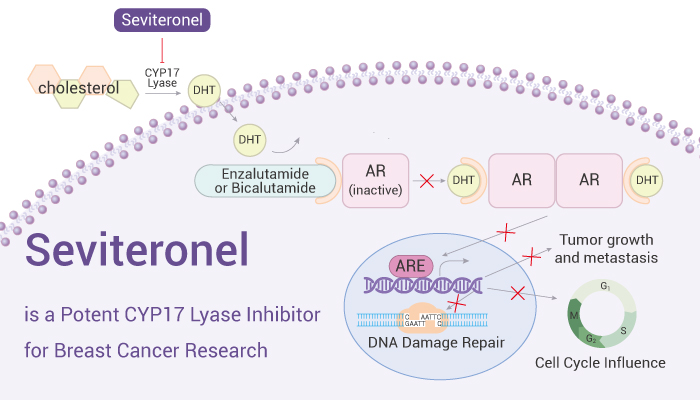As reported, triple negative breast cancer (TNBC) is a heterogeneous cancer subtype lack of estrogen receptor, progesterone receptor, or HER2. Thus, there is still a clinical need for the development of new anticancer strategies for TNBC. Noticeably, Researchers found that androgen receptor (AR) expresses in 15-35% of all TNBCs, demonstrating that it’s an effective target for the clinical cancer research. Otherwise, efforts to target AR signaling usually focuses on decreasing circulating androgens (CYP17 inhibition) or blocking the binding of androgens to their cognate receptor (AR inhibition). However, production of androgens is dependent upon the activity of CYP17 lyase. Therefore, Inhibitors of CYP17 lyase are potential strategy, and can be used for breast cancer research. Meanwhile, Seviteronel (INO-464) is a novel inhibitor of both CYP17 lyase and AR.

Seviteronel is an orally active CYP17 lyase inhibitor for TNBC research.
In vitro, Seviteronel inhibits CYP17 lyase with an IC50 of 69 nM. Besides, Seviteronel can not only directly bind AR and prevent androgen-mediated gene expression, but also reduces the nuclear translocation and accumulation of AR. In addition, Seviteronel (5 μM) increases radiosensitivity (2 Gy) in MDA-MB-453 cells (an AR+ TNBC cell line). Meanwhile, it has no effect in TNBC cells with low AR expression. Furthermore, Seviteronel (5 μM) results in accumulation of dsDNA breaks following radiation in AR+ TNBC cells.
In vivo, Seviteronel (75 mg/kg, p.o., everyday) in combination with radiation (2 Gy) shows synergistic antitumor effect in MDA-MB-453 xenograft tumor mice. In addition, Seviteronel (150mg/kg/day, p.o.) significantly decreases the growth of the AR-V7+ 22Rv1 CPRC nu/nu mice xenograft model, and shows a synergistic antitumor effect with G1T38 (CDK4/6 inhibitor).
To sum up, Seviteronel is an orally active CYP17 lyase inhibitor, and can be used for AR+ breast cancer research, such as TNBC.
References:
[1] Michmerhuizen AR, et al. Front Endocrinol (Lausanne). 2020 Feb 11;11:35.
[2] Suzanne E. Wardell; et al. Cancer Res (2017) 77 (13_Supplement): 1588. 2017
[3] Stone A, et al. Cancers (Basel). 2023 Nov 30;15(23):5664.